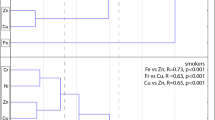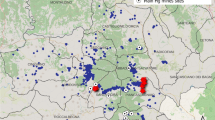Abstract
The exposure of heavy metals (lead (Pb), cadmium (Cd), copper (Cu), nickel (Ni), and metalloid arsenicals) and their effects on workers’ health from a lead-zinc mine (145 workers) and a steel smelting plant (162 workers) was investigated. Information on subject characteristics was obtained through a questionnaire. We determined the urinary levels of Pb, Cd, Cu, Ni, and arsenicals (including inorganic arsenic (iAs), monomethylarsonic acid (MMA), and dimethylarsinic acid (DMA), as were 8-hydroxydeoxyguanosine (8-OHdG) and cystatin C. Lead-zinc mine foundry workers had significantly higher concentrations of urinary Pb, Cd, Cu, Ni, iAs, and MMA than did steel smelting plant workers. Individuals who had consumed seafood in the previous 3 days had higher concentrations of urinary Ni than did individuals who had not consumed seafood. The urinary Cd concentrations in the two groups of factory workers may have been affected by daily smoking. There was no significant difference in urinary 8-OHdG between workers from the lead-zinc mine foundry and the steel smelting plant. Urinary Pb and Cd had significant positive linear dose-dependent effects on 8-OHdG. Urinary cystatin C, a sensitive biological indicator reflecting early renal damage, was found at higher levels in lead-zinc mine workers than in steel smelting plant workers. Binary logistic regression analysis showed that age and urinary Cd were significantly associated with urinary cystatin C. These results indicated that workers from lead-zinc mines may be exposed to higher levels of heavy metals which could lead to greater risk of kidney damage.
Similar content being viewed by others
References
Garcia-Nino WR, Pedraza-Chaverri J (2014) Protective effect of curcumin against heavy metals-induced liver damage. Food Chem Toxicol 69:182–201
Paul D (2017) Research on heavy metal pollution of river ganga: a review. Ann Agric Sci 15:278–286
Pal R, Mahima GA et al (2014) Assessment of heavy metals in suspended particulate matter in Moradabad, India. J Environ Biol 35(2):357–361
Cheng S (2003) Heavy metal pollution in China: origin, pattern and control. Environ Sci Pollut Res Int 10(3):192–198
Abarikwu SO, Essien EB, Iyede OO et al (2017) Biomarkers of oxidative stress and health risk assessment of heavy metal contaminated aquatic and terrestrial organisms by oil extraction industry in Ogale, Nigeria. Chemosphere 185:412–422
Boffetta P, Fontana L, Stewart P et al (2011) Occupational exposure to arsenic, cadmium, chromium, lead and nickel, and renal cell carcinoma: a case-control study from Central and Eastern Europe. Occup Environ Med 68(10):723–728
Andrade VM, Aschner M, Marreilha DSA (2017) Neurotoxicity of metal mixtures. Adv Neurobiol 18:227–265
Poreba R, Gac P, Poreba M et al (2012) Assessment of cardiovascular risk in workers occupationally exposed to lead without clinical presentation of cardiac involvement. Environ Toxicol Pharmacol 34(2):351–357
WHO (2004) Cadmium and cadmium compounds. Rep Carcinog 11: I42–I44
Wang Y, Mandal AK, Son Y-OK et al (2018) Roles of ROS, Nrf2, and autophagy in cadmium-carcinogenesis and its prevention by sulforaphane. Toxicol Appl Pharmacol 353:23–30
Xu MY, Wang P, Sun YJ et al (2017) Joint toxicity of chlorpyrifos and cadmium on the oxidative stress and mitochondrial damage in neuronal cells. Food Chem Toxicol 103:246–252
Lubin JH, Moore LE, Fraumeni JJ et al (2008) Respiratory cancer and inhaled inorganic arsenic in copper smelters workers: a linear relationship with cumulative exposure that increases with concentration. Environ Health Perspect 116(12):1661–1665
Shuhua X, Qingshan S, Fei W et al (2014) The factors influencing urinary arsenic excretion and metabolism of workers in steel and iron smelting foundry. J Expo Sci Environ Epidemiol 24(1):36–41
Ford M (2002) Arsemc. In: Goldfrank LR, Flomenbaum NE, Lewin NA et al (eds) Goldfrank’S Toxicologic Emergencies, 7th edn. McGraw-Hill, New York
Nesnow S, Roop BC, Lambert G et al (2002) DNA damage induced by methylated trivalent arsenicals is mediated by reactive oxygen species. Chem Res Toxicol 15(12):1627–1634
Jeng HA, Pan CH, Diawara N et al (2011) Polycyclic aromatic hydrocarbon-induced oxidative stress and lipid peroxidation in relation to immunological alteration. Occup Environ Med 68(9):653–658
Junaid M, Hashmi MZ, Malik RN et al (2016) Toxicity and oxidative stress induced by chromium in workers exposed from different occupational settings around the globe: a review. Environ Sci Pollut Res Int 23(20):20151–20167
Wu LL, Chiou CC, Chang PY, Wu JT (2004) Urinary 8-OHdG: a marker of oxidative stress to DNA and a risk factor for cancer, atherosclerosis and diabetics. Clin Chim Acta 339:1–9
WHO (1996) Biological monitoring of chemical exposure in the workplace, vol 1. World Health Organization, Geneva
Linsinger T (2005) Comparison of a measurement result with the certified value. Eur Ref Mater:1–2
Xu Y, Wang Y, Li X, He M, Xue P, Fu J et al (2009) Variations in arsenic methylation capacity and oxidative DNA lesions over a 2-year period in a high arsenic-exposed population. Int Arch Occup Environ Health 82:251–258
Sun G, Xu Y, Li X et al (2007) Urinary arsenic metabolites in children and adults exposed to arsenic in drinking water in Inner Mongolia, China. Environ Health Perspect 115(4):648–652
Ma M, Le XC (1998) Effect of arsenosugar ingestion on urinary arsenic speciation. Clin Chem 44(3):539–550
Francesconi KA, Tanggaar R, Mckenzie CJ et al (2002) Arsenic metabolites in human urine after ingestion of an arsenosugar. Clin Chem 48(1):92–101
Togashi Y, Sakaguchi Y, Miyamoto M et al (2012) Urinary cystatin C as a biomarker for acute kidney injury and its immunohistochemical localization in kidney in the CDDP-treated rats. Exp Toxicol Pathol 64(7–8):797–805
Marcos R, Martinez V, Hernandez A et al (2006) Metabolic profile in workers occupationally exposed to arsenic: role of GST polymorphisms. J Occup Environ Med 48(3):334–341
Raml R, Goessler W, Traar P et al (2005) Novel thioarsenic metabolites in human urine after ingestion of an arsenosugar, 2′,3′-dihydroxypropyl 5-deoxy-5-dimethylarsinoyl-beta-D-riboside. Chem Res Toxicol 18(9):1444–1450
Schmeisser E, Goessler W, Francesconi KA (2006) Human metabolism of arsenolipids present in cod liver. Anal Bioanal Chem 385(2):367–376
Choi BS, Choi SJ, Kim DW et al (2010) Effects of repeated seafood consumption on urinary excretion of arsenic species by volunteers. Arch Environ Contam Toxicol 58(1):222–229
Xu L, Sun G, Xu Y et al (2008) Effect of seaweed intake on urinary arsenic excretion. Chin J Public Health 24:1093–1094
Nersesyan A, Kundi M, Waldherr M et al (2016) Results of micronucleus assays with individuals who are occupationally and environmentally exposed to mercury, lead and cadmium. Mutat Res 770(Pt A):119–139
Waalkes MP (2000) Cadmium carcinogenesis in review. J Inorg Biochem 79:241–244
Brzoska MM, Moniuszko-Jakoniuk J (2005) Disorders in bone metabolism of female rats chronically exposed to cadmium. Toxicol Appl Pharmacol 202(1):68–83
Johri N, Jacquillet G, Unwin R (2010) Heavy metal poisoning: the effects of cadmium on the kidney. Biometals 23(5):783–792
El-Boshy M, Ashshi A, Gaith M et al (2017) Studies on the protective effect of the artichoke (Cynarascolymus) leaf extract against cadmium toxicity-induced oxidative stress, hepatorenal damage, and immunosuppressive and hematological disorders in rats. Environ Sci Pollut Res Int 24(13):12372–12383
Laterza OF, Price CP, Scott MG (2002) Cystatin C: an improved estimator of glomerular filtration rate? Clin Chem 48(5):699–707
Straif K, Benbrahim-Tallaa L, Baan R et al (2009) A review of human carcinogens—part C: metals, arsenic, dusts, and fibres. Lancet Oncol 10:453–454
Hu CW, Pan CH, Huang YL et al (2006) Effects of arsenic exposure among semiconductor workers: a cautionary note on urinary 8-oxo-7,8-dihydro-2′-deoxyguanosine. Free Radic Biol Med 40:1273–1278
Lin TS, Wu CC, Wu JD et al (2012) Oxidative DNA damage estimated by urinary 8-hydroxy-2′-deoxyguanosine and arsenic in glass production workers. Toxicol Ind Health 28:513–521
Wong RH, Kuo CY, Hsu ML et al (2005) Increased levels of 8-hydroxy-2-deoxyguanosine attributable to carcinogenic metal exposure among school children. Environ Health Perspect 113:1386–1390
Xu Y, Wang Y, Zheng Q et al (2008) Association of oxidative stress with arsenic methylation in chronic arsenic-exposed children and adults. Toxicol Appl Pharmacol 232:142–149
Wang T, Feng W, Kuang D et al (2015) The effects of heavy metals and their interactions with polycyclic aromatic hydrocarbons on the oxidative stress among coke-oven workers. Environ Res 140:405–413
Acknowledgements
This work was supported by the National Natural Science Foundation of China (NSFC) (81673207). We thank International Science Editing (http://www.internationalscienceediting.com) for editing this manuscript.
Author information
Authors and Affiliations
Corresponding author
Ethics declarations
Conflict of Interest
The authors declare that they have no conflict of interest.
Rights and permissions
About this article
Cite this article
Wang, X., Jin, P., Zhou, Q. et al. Metal Biomonitoring and Comparative Assessment in Urine of Workers in Lead-Zinc and Steel-Iron Mining and Smelting. Biol Trace Elem Res 189, 1–9 (2019). https://doi.org/10.1007/s12011-018-1449-0
Received:
Accepted:
Published:
Issue Date:
DOI: https://doi.org/10.1007/s12011-018-1449-0




